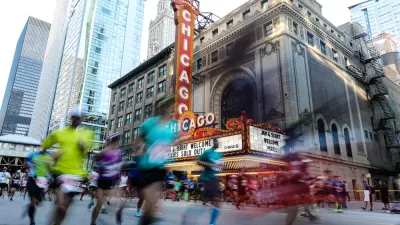A Grist writer and environmentalist takes a trip to the Talladega Superspeedway to try to understand what the petroleum-wasting is really all about.
"You also have to factor in the tires for every race. Several gallons of oil go into the production of a synthetic rubber tire. One car competing in a NASCAR event burns through 40 to 80 tires per race. Additionally, each team has a convoy of 18-wheelers that hauls its race cars across the country from track to track, cumulatively traveling hundreds of thousands of miles per year. Fully loaded, these trucks get around 4.5 miles per gallon, which means that millions of gallons are consumed in just getting the cars to the races.
These numbers are small when compared to the volume of fuel that goes into America's military endeavors or our daily commutes, let alone our total oil demand. What's fascinating about this particular form of fuel consumption is that its purpose is sheer entertainment. This is gas consumption as an art form."
FULL STORY: NASCAR and the high-octane American dream

Study: Maui’s Plan to Convert Vacation Rentals to Long-Term Housing Could Cause Nearly $1 Billion Economic Loss
The plan would reduce visitor accommodation by 25,% resulting in 1,900 jobs lost.

North Texas Transit Leaders Tout Benefits of TOD for Growing Region
At a summit focused on transit-oriented development, policymakers discussed how North Texas’ expanded light rail system can serve as a tool for economic growth.

Why Should We Subsidize Public Transportation?
Many public transit agencies face financial stress due to rising costs, declining fare revenue, and declining subsidies. Transit advocates must provide a strong business case for increasing public transit funding.

How to Make US Trains Faster
Changes to boarding platforms and a switch to electric trains could improve U.S. passenger rail service without the added cost of high-speed rail.

Columbia’s Revitalized ‘Loop’ Is a Hub for Local Entrepreneurs
A focus on small businesses is helping a commercial corridor in Columbia, Missouri thrive.

Invasive Insect Threatens Minnesota’s Ash Forests
The Emerald Ash Borer is a rapidly spreading invasive pest threatening Minnesota’s ash trees, and homeowners are encouraged to plant diverse replacement species, avoid moving ash firewood, and monitor for signs of infestation.
Urban Design for Planners 1: Software Tools
This six-course series explores essential urban design concepts using open source software and equips planners with the tools they need to participate fully in the urban design process.
Planning for Universal Design
Learn the tools for implementing Universal Design in planning regulations.
Ascent Environmental
Borough of Carlisle
Institute for Housing and Urban Development Studies (IHS)
City of Grandview
Harvard GSD Executive Education
Toledo-Lucas County Plan Commissions
Salt Lake City
NYU Wagner Graduate School of Public Service




























